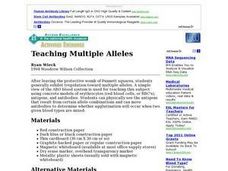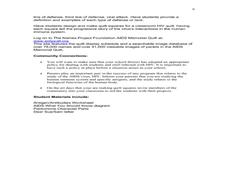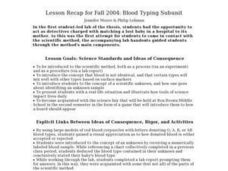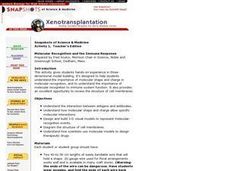Curated OER
Regents High School Examination: Biology 2006
Twenty-six pages of biology questions, mostly in multiple-choice form, are included in the all-encompassing New York State Regents exam. It assesses every topic typically covered in a high-school biology course. Create your own answer...
Curated OER
Disease Diagnosis
Young scholars comprehend how biotechnology can be used to diagnose infectious disease such as protein technologies vs. DNA technologies. They comprehend procedure and uses of PCR, Western Blot, and ELISA as diagnostic tools. Students...
Curated OER
The Immune System
Activate the immune system in the brains of your biologists! This worksheet calls upon learners to explain the structure, function, and problems associated with the immune system. This worksheet is helpful for the advanced placement...
Curated OER
Biology Jeopardy
Play Jeopardy as you review what might possibly be an entire year's high school biology course! The vast variety of questions requires that you read through the slides to make sure that they all relate to your curriculum. You could make...
Curated OER
ABO Blood Types Worksheet
Blood types and transfusions are explained in reading passages at the top of the worksheet. A chart of blood type compatibility is also provided. Biology students answer comprehension questions and then exercise critical-thinking skills...
Curated OER
Antibodies
Students conduct a series of exploration activity on how vaccines and antibodies work. In this biology lesson, students test how antigens and antibodies work in the body. They discuss the benefits of vaccines in promoting immune responses.
Curated OER
Antibody Center Template
In this antibodies worksheet, students use model diagrams of antigens, antibodies and blood cells to develop a visual understanding of the immune system. They draw diagrams of antibodies and antigens attached to each other and answer...
Curated OER
Blood
For this blood worksheet, students complete a crossword puzzle given 24 clues about the components of the blood, the cells of the blood and the immune system with its antigens and antibodies found in the blood.
Curated OER
Defense Against Infectious Diseases
In this infectious diseases instructional activity, students read about the two types of defenses the body has against pathogens: innate (nonspecific) and adaptive (specific). Students then complete a graphic organizer by filling in 11...
Curated OER
The Nature of Disease
For this disease worksheet, students read information about infectious diseases, how they are transmitted, and how they are treated. Students then complete 6 fill in the blank questions.
Curated OER
A Pox No Longer Upon Us
Tenth graders research the development and use of vaccines. They examine historical documents for qualitative observations and the basis of immunization. They examine primary and secondary immune responses as they relate to the...
Curated OER
Teaching Multiple Alleles
Students view a simple ABO blood system for the introduction of this subject using concrete models of eythrocytes (red blood cells, or RBC's), antigens, and antibodies. They can physically see the antigens that result from certain...
Curated OER
Fighting Back!
Fifth graders inspect the basic functions of the immune system and determine how viruses and bacteria invade the immune system. They also explore what happens to the immune system in outer space.
Curated OER
Antigens versus Antibodies "KO'd in Round Three" The Third Line of Defense of the Human Immune System
Seventh graders investigate antibodies, as the body's third line of defense against disease. They discover why antibodies do not defend the body against viruses and create a pantomime of the antibody/antigen/HIV relationship.
Curated OER
Blood Typing Subunit
Students play the role of science detectives in an activity used to introduce the scientific method and the concept that blood is not identical and is identified by surface markers. Students must identify an unknown sample of "blood" by...
Curated OER
Antibodies and Antigens: Fitting Together
Using basic matching, aspiring biologists connect types of antigens with the antibodies that fight them. Provide ample instruction prior to assigning this one-sheet resource. Require students to explain in writing how each antibody works...
Curated OER
Using Blood Tests to Identify Babies and Criminals
Students solve a crime by matching a suspect's blood type to physical evidence collected at the crime scene. In this forensic science lesson, students identify the different blood types. They explain how blood tests work.
Curated OER
Antigens
Students examine antigens including ones found in humans. In this immune lesson students complete several experiments in relation to antigens and antibodies.
Curated OER
Internal Systems and Regulation
In this internal systems and regulation worksheet, students correctly decide if given statements are true or false. Students apply information learned about the circulatory system to the given statements to determine statements of truth...
Curated OER
Anatomy and Physiology Study Questions on Immunology
In this anatomy and physiology study question worksheet, students define 20 terms related to the immune system. They answer 19 short answer questions that deal with immunology, autoimmune diseases, and the components and cells related to...
Curated OER
Outbreak!
Young scholars study and research drug-resistant bacteria and the use of antibiotics. Through the use of the internet, and other resources, students gather information and create a board game. They discuss bacteria, antibodies,...
Curated OER
Molecular Recognition and the Immune Response
Students explore the importance of molecular shape and charge in molecular-recognition. They examine the interaction between antigens and antibodies. Students design and build 3-D visual models to represent molecular-recognition...
Curated OER
Multiple Alleles
Students observe models of the ABO blood system including erythrocytes, antigens, and antibodies. They investigate the antigens that result from certain allele combinations and move antibodies to determine whether agglutination occurs...
Curated OER
The Genetics of Antibody Diversity
Students distinguish between the light and heavy chain sections. For this biology lesson, students simulate the DNA splicing process. They calculate antibody diversity using the information given.

























